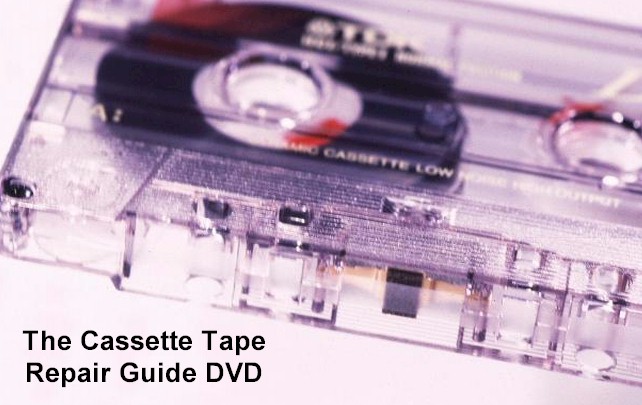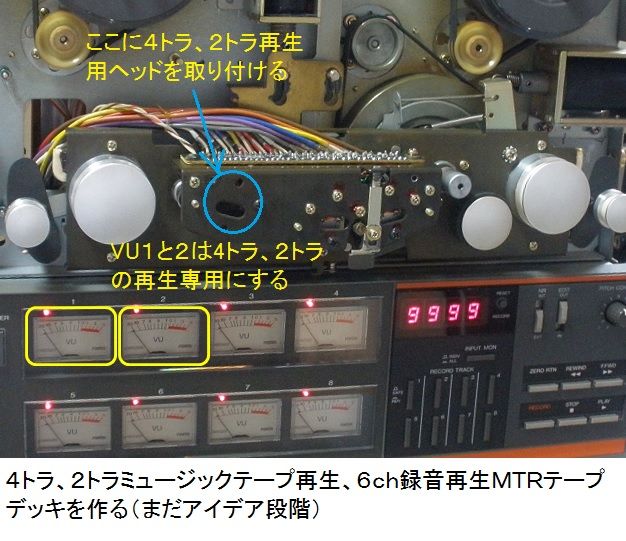
There are two ways the solenoid can be triggered, either through pressing the selector button on the front of the unit, or by a piece of conductive foil at the join of the tape loop passing a pair of electrical contacts to automatically change tracks. There is a cam that is rotated incrementally through four positions by a solenoid, this cam moves the head up and down between the tracks. Turning the chassis over, along with the electronics and the motor, we see the business end of an 8-track player, the solenoid and mechanism that allows it to change tracks. It’s possible that this is because the same basic mechanism was used in a range of BSR products, though the 8-track format didn’t really take off in the UK it’s likely BSR would have sold this mechanism to other manufacturers in the same way they did for their turntables. The front half is the 8-track mechanism, while the rear holds the motor and the circuit board. Upon inspection the chassis is revealed to be in two parts held together with self-tapping screws. An interlude of picking, rubbing, and scraping with tissue paper ensued, along with my hands getting covered in black gunk before a trip to the sink for a date with some industrial hand cleaner. This is very common in belts from the 1970s, I’m told it has something to do with how well the rubber was cured. Immediately, an unfortunate side-effect of an ancient piece of equipment became apparent, in the decades since this player was last used the drive belt has softened and turned to a sticky black tar-like substance. The motor is also the mains transformer for the electronics, a characteristic BSR cost-saving trick that you would also have found in record players of the period. A very solid sheet steel chassis is revealed, with a mains-powered shaded pole motor and a belt drive to a substantial cast aluminium flywheel on the pinch roller shaft. Turning the unit over, unscrewing the feet allows the cover to be slid off to reveal the mechanism.

Sticky belt debris still attached to everything. There was a period in the 1970s when DIN connectors were where it was at when it came to audio. On the rear panel is an audio level control and the cables, the audio output is brought to a DIN plug instead of the phonos we’d more commonly find today. The outer case is made from fibreboard covered in stick-on wood-effect vinyl as was the fashion of the day, and the front panel has the cartridge slot and track selector button. The player itself is about half the size of a normal hi-fi unit, instead of the normal roughly a 19 inch rack size it’s about 9 inches (23 cm) wide and 4.5 inches (11.5 cm) high. So every incarnation of listening enjoyment chez List for the last quarter century has had an 8-track player nestling within it, even if it has never played a tape while in my ownership. Thus we have a unique opportunity for this retro teardown. I certainly didn’t buy it because I wanted it to play 8-track tapes, instead I wanted a talking point for my hi-fi, something quirky to set it apart from everyone else’s. Where I found it has disappeared into the mists of time, but it was probably at a radio rally or junk sale. BSR were much more well-known for their turntables, so this is something of an oddity.


Some time in the early 1990s, I acquired an 8-track player, a BSR McDonald unit manufactured in the UK and dating from the early 1970s.
#8 TRACK TAPE REPAIR PARTS SERIES#
Our retrotechtacular series usually highlights a video showing a bygone technology, but today we’re going to get a little more hands-on. Thus if you owned an 8-track player it was most likely to have been found in your car, but it was not uncommon to find them also incorporated into home hi-fi systems. Thus we come to our subject today. Government & Heritage Library, State Library of NC (CC BY 2.0).Ĩ-track cartridges were developed from earlier tape cartridge formats, largely to satisfy the demands of the automotive industry for interchangeable in-car entertainment. A triumph of marketing, really, it should more accurately have been called 4-track stereo. One of several that you might have found in a well-equipped home of that period was the 8-track stereo cartridge, a self-contained tape cassette format that fit four stereo tracks onto a single quarter-inch tape loop as eight parallel tracks, four each of left and right. If you are of a certain age you may even have a cassette deck, though you’re more likely to have abandoned that format some time in the 1990s. If you are old enough to have been around in the 1960s or 1970s though, you may have owned another analogue audio format. If you are a connoisseur of analogue audio, it’s probable you might have a turntable and a stack of records at home somewhere.


 0 kommentar(er)
0 kommentar(er)
